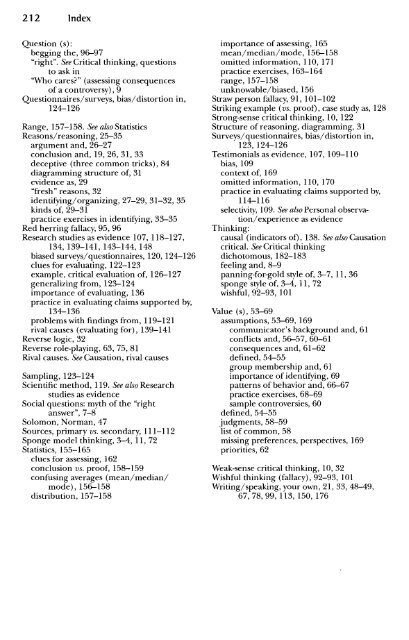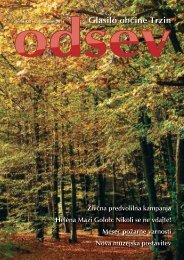Asking the Right Questions, A Guide to Critical Thinking, 8th Ed
Asking the Right Questions, A Guide to Critical Thinking, 8th Ed
Asking the Right Questions, A Guide to Critical Thinking, 8th Ed
Create successful ePaper yourself
Turn your PDF publications into a flip-book with our unique Google optimized e-Paper software.
212 Index<br />
Question (s):<br />
begging <strong>the</strong>, 96-97<br />
"right". See <strong>Critical</strong> thinking, questions<br />
<strong>to</strong> ask in<br />
"Who cares?" (assessing consequences<br />
of a controversy), 9<br />
Questionnaires/surveys, bias/dis<strong>to</strong>rtion in,<br />
124-126<br />
Range, 157-158. See also Statistics<br />
Reasons/reasoning, 25-35<br />
argument and, 26-27<br />
conclusion and, 19, 26, 31, 33<br />
deceptive (three common tricks), 84<br />
diagramming structure of, 31<br />
evidence as, 29<br />
"fresh" reasons, 32<br />
identifying/organizing, 27-29, 31-32, 35<br />
kinds of, 29-31<br />
practice exercises in identifying, 33-35<br />
Red herring fallacy, 95, 96<br />
Research studies as evidence 107, 118-127,<br />
134, 139-141, 143-144, 148<br />
biased surveys/questionnaires, 120, 124—126<br />
clues for evaluating, 122-123<br />
example, critical evaluation of, 126-127<br />
generalizing from, 123-124<br />
importance of evaluating, 136<br />
practice in evaluating claims supported by,<br />
134-136<br />
problems with findings from, 119-121<br />
rival causes (evaluating for), 139-141<br />
Reverse logic, 32<br />
Reverse role-playing, 63, 75, 81<br />
Rival causes. See Causation, rival causes<br />
Sampling, 123-124<br />
Scientific method, 119. See also Research<br />
studies as evidence<br />
Social questions: myth of <strong>the</strong> "right<br />
answer", 7-8<br />
Solomon, Norman, 47<br />
Sources, primary vs. secondary, 111-112<br />
Sponge model thinking, 3-4, 11, 72<br />
Statistics, 155-165<br />
clues for assessing, 162<br />
conclusion vs. proof, 158-159<br />
confusing averages (mean/median/<br />
mode), 156-158<br />
distribution, 157-158<br />
importance of assessing, 165<br />
mean/median/mode, 156-158<br />
omitted information, 110, 171<br />
practice exercises, 163-164<br />
range, 157-158<br />
unknowable/biased, 156<br />
Straw person fallacy, 91, 101-102<br />
Striking example (vs. proof), case study as, 128<br />
Strong-sense critical thinking, 10, 122<br />
Structure of reasoning, diagramming, 31<br />
Surveys/questionnaires, bias/dis<strong>to</strong>rtion in,<br />
123,124-126<br />
Testimonials as evidence, 107, 109-110<br />
bias, 109<br />
context of, 169<br />
omitted information, 110, 170<br />
practice in evaluating claims supported by,<br />
114-116<br />
selectivity, 109. See also Personal observation/experience<br />
as evidence<br />
<strong>Thinking</strong>:<br />
causal (indica<strong>to</strong>rs of), 138. See also Causation<br />
critical. See <strong>Critical</strong> thinking<br />
dicho<strong>to</strong>mous, 182-183<br />
feeling and, 8-9<br />
panning-for-gold style of, 3-7, 11, 36<br />
sponge style of, 3-4, 11, 72<br />
wishful, 92-93, 101<br />
Value (s), 53-69<br />
assumptions, 53-69, 169<br />
communica<strong>to</strong>r's background and, 61<br />
conflicts and, 56-57, 60-61<br />
consequences and, 61-62<br />
defined, 54-55<br />
group membership and, 61<br />
importance of identifying, 69<br />
patterns of behavior and, 66-67<br />
practice exercises, 68-69<br />
sample controversies, 60<br />
defined, 54-55<br />
judgments, 58-59<br />
list of common, 58<br />
missing preferences, perspectives, 169<br />
priorities, 62<br />
Weak-sense critical thinking, 10, 32<br />
Wishful thinking (fallacy), 92-93, 101<br />
Writing/speaking, your own, 21, 33, 48-49,<br />
67,78,99, 113, 150, 176



